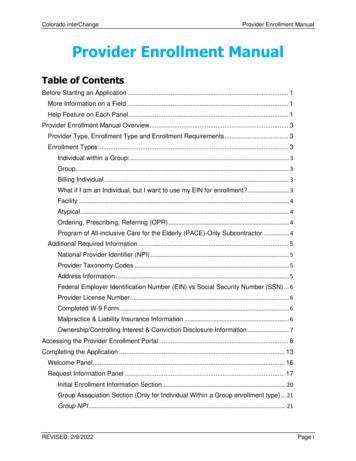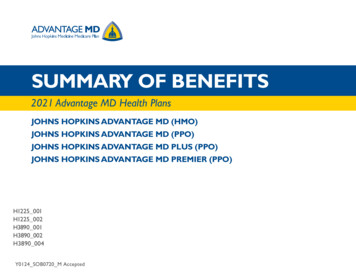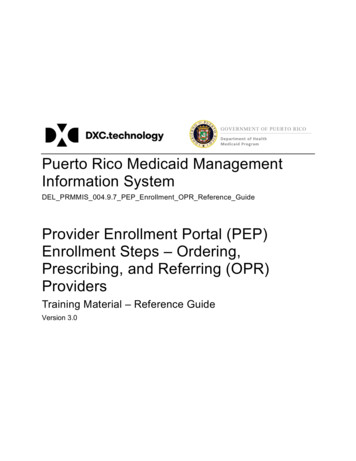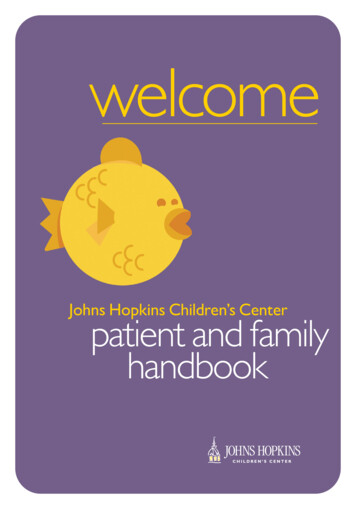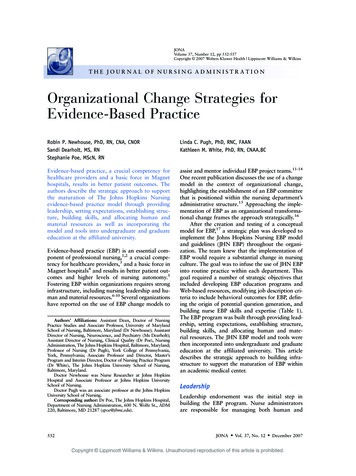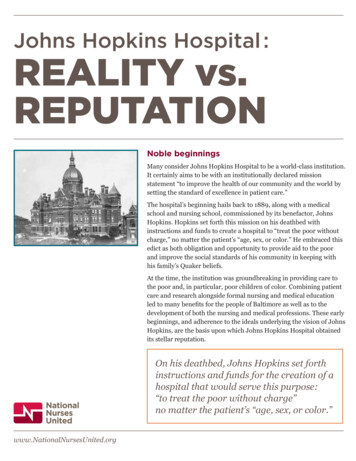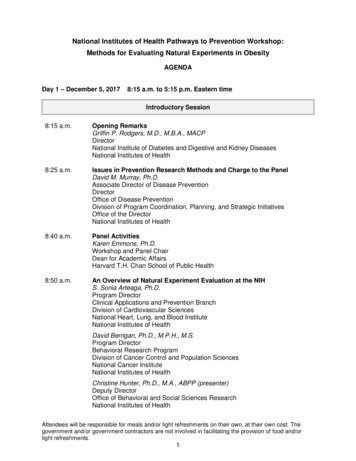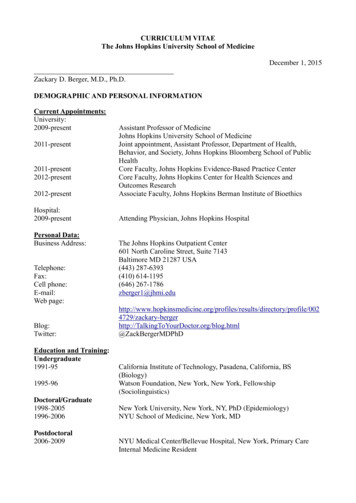
Transcription
2022 BenefitsEnrollment GuideFor Bargaining Unit Members
Table of Contents3 Getting Started4 Your Benefits At-A-Glance5 Participating in the Benefits ProgramWho Is Eligible.5Coverage Levels.5When Coverage Begins.5How Long Coverage Lasts.5Sharing the Cost for Coverage.66 Medical PlanUnderstand and Compare Your Medical Options.7CareFirst BlueCross BlueShield Plan.7The HMOs: BlueChoice and Kaiser Permanente.781011121314Health Plan Comparison ChartPrescription Drug BenefitsPreventive Care BenefitsHealthy at HopkinsKnow Before You GoDental PlanDental Plan Comparison.1515 Vision Plan16 Flexible Spending Accounts (FSAs)Health Care FSA.17Dependent Care FSA. 1819 Life InsuranceLife Insurance (Basic and Supplemental).19Designating Your Beneficiary.19Dependent Life Insurance.1919 Disability ProtectionShort-Term Disability Plan.19Long-Term Disability Plan.1919 Voluntary Insurance BenefitsAllstate Identity Theft Protection.20Nationwide Pet Insurance.20Choice Auto/Homeowner’s Insurance.20MetLife Critical Illness Insurance.20MetLife Accident Insurance.20MetLife Legal Plan.2021 Bargaining Unit Employees’ Pension Plan21 Staff Voluntary 403(b) Retirement Plan21 Tuition Benefits22 Resources2
Welcome to myChoices, your comprehensive and competitive benefits program!Our benefits program can help you be well by choosing well.You can have a positive effect on your own health and your health care costs.Here are just a few ways you can make a difference:Take advantage of preventivebenefits. Routine physicals andhealth screenings are available at nocost to you.Take charge of your health. You canparticipate in a free care managementprogram to help you manage a chroniccondition.Try telehealth. Telehealth servicesoffer a convenient way to get medicalcare for non-emergency needs.Get help from mySupport. OurmySupport program offers free,confidential help with personal challenges.Getting StartedBefore choosing your benefits elections forthis year, carefully review this guide andinformation available to you online athr.jhu.edu/benefits-worklife. These resourceswill help you make informed choices.If you have questions about your benefits orhow to enroll, you can contact the BenefitsService Center by phone, email, fax, or mail.Phone: 410-516-2000Fax: 443-997-5820Email: benefits@jhu.eduAddress:Benefits Service CenterJohns Hopkins University1101 East 33rd Street, Suite D200Baltimore, MD 21218This enrollment guide provides highlights of the Johns Hopkins University Plans for bargaining unit employees. The university hasmade every effort to ensure that this guide accurately reflects the plan documents and contracts. If there is a discrepancy between thisguide and those documents or contracts, the documents, summary plan descriptions, or contracts will take precedence.3
Your Benefits At-A-GlanceThe chart below summarizes your health and welfare plans and the options available to you.Benefits marked with a check are fully paid by Johns Hopkins University.Medical Plans(includes prescription drugcoverage through ExpressScripts or Kaiser Permanente,depending on the plan youchoose)q CareFirst BlueCross BlueShield PPO Planq BlueChoice HMOq Kaiser Permanente HMODental Plansq Delta Dental Standard DPPO Planq Delta Dental Enhanced with Orthodontia DPPO PlanVision Planq EyeMed Vision PlanFlexible Spending Accounts(FSAs)q Health Care Flexible Spending Accountq Dependent Care Flexible Spending AccountLife InsuranceLife Insurance:*ü 100% of base salaryq Additional 100% of base salaryDependent Life Insurance:ü 4,000 for spouse or domestic partner and 2,000 per child*Note: JHU pays the full cost for 100% of base salary; if you select additionalcoverage, you pay the difference and evidence of insurability will be required.Disability Protectionq Short-Term Disability: benefits generally continue at 60% ofpre-disability pay for up to 11 weeks (to a maximum of 2,500weekly)ü L ong-Term Disability:** after 90 consecutive days, benefitsgenerally continue at 60% of pre-disability pay (up to 10,000monthly)**Eligible on first day of month coincident with or next following one year ofbenefits-eligible employment unless proof of prior immediate coverage isprovided.4Voluntary Benefitsq Identity Theft Protectionq Pet Insuranceq Auto Insuranceq Homeowner’s Insuranceq Critical Illness Insuranceq Accident Insuranceq Legal PlanAdditional Programsq JHU Child Care Voucher Programq Scholarships to JHU Child Care Centers
Participating in the Benefits ProgramWho Is EligibleWhen Coverage BeginsYou are eligible to enroll in myChoices as long asyou are a full-time bargaining unit employee atthe university. You may also cover your eligibledependents, as follows:Your benefits start date is generally the first dayof employment in an eligible status (usually, yourfirst day of work after your probationary period).However, if you are not at work due to an illnessor injury on the date your university-paid lifeinsurance would take effect, your life insurancewill not take effect until you return to work for onefull day. Your legally married spouse or domestic partner* Your children up until the end of the year inwhich your dependent turns age 26; coveragemay be continued for children up to any ageif they cannot support themselves because ofa mental or physical disability (certificationof disability is required—contact your medicalinsurance provider for more information)How Long Coverage LastsThe choices you make now will remain in effectthrough the end of the plan year, unless you havea change in:For this purpose, “children” are biological children,adopted children, children placed with the eligibleemployee for adoption, stepchildren, children ofthe employee’s domestic partner, or children forwhom the eligible employee has been appointedlegal guardian. You will need to submit dependentdocumentation. T he number of your dependents as a result ofbirth, adoption, change in guardianship, death, ordissolution of a domestic partnershipCoverage Levels E mployment status for you or your spouse,domestic partner, or dependentWhen you enroll, you’ll choose your coveragelevel for medical and dental. Dependents may becovered only under the plan you elect for yourself.The types of coverage available are: Individual – bargaining unit employee 1 Adult and Children – bargaining unit employeeand one or more children 2 Adults – bargaining unit employee and spouseor domestic partner* 2 Adults and Children – bargaining unitemployee, spouse or domestic partner,* and oneor more children*Must qualify for coverage under the Johns HopkinsUniversity Domestic Partnership Benefits Policy,which can be found on the Benefits website sources/domestic-partner-benefits-policy. Y our marital status (e.g., marriage, certificationof domestic partnership, divorce, or death of aspouse or domestic partner) A ccess to coverage, place of residence, oremployment for you or your spouse, domesticpartner, or dependent Y our child’s eligibility for coverage as a result ofa judgment, decree, or order (including a QualifiedMedical Child Support Order) A ny event that causes a dependent to satisfy orcease to satisfy requirements for coverage asspecified by the planIf any of these qualified life events occur, youcan make an election that’s consistent with thechange within 30 days. If you or your covereddependent(s) lose Medicaid or Children’s HealthInsurance Program (CHIP) coverage, or if youbecome eligible for state premium assistance, youhave 60 days to make changes to your coverage.You are not required to enroll your spouse ordomestic partner for medical coverage. However,if you are choosing to disenroll a formerlycovered spouse or domestic partner because ofa termination in the relationship, be sureto complete a Termination of Marriage orDomestic Partnership form (available rmination1.pdf).5
Sharing the Cost for CoverageYou and the university share in the cost of your benefitscoverage. The university pays the majority of the plan costs;you pay the remaining balance.Sharing the Cost of CoverageUniversity-paid portionPortion paid by you*Note: Chart is a representation and does not reflect any specific circumstance.When you enroll, you will pay for your benefits elections with pre-tax dollars deducted from your paycheck.Medical PlanYou can choose from three medical plans: CareFirst BlueCross BlueShield (BCBS) – a Preferred Provider Organization (PPO) BlueChoice – a health maintenance organization (HMO) Kaiser Permanente – a health maintenance organization (HMO)You may also choose not to elect coverage.All options provide benefits coverage for preventive, routine, and emergency medical treatments andservices. NEW: Starting in 2022, our plans will now include coverage for hearing aids, up to 1,000 perear every three years with no age limitations.See the table below for more information about how your plan options differ in some important ways.How the Medical Plans ComparePlan TypePreferred Provider Organization (PPO)Health Maintenance Organization (HMO)Choice ofproviderSee any provider, in-network orout-of-network; you generally paymore for out-of-network careProvider must be part of HMO’s networkPCP/referralsneededNoYesWhat you payout-of-pocketYou pay an annual deductible, thenthe plan generally pays 80% each timeyou need care (you pay the remainingbalance). You pay more if seeing anout-of-network providerNo deductible; you pay a copay, then theplan pays the remaining balanceRefer to the Health Plan Comparison Chart on page 8 for a side-by-side comparison ofthe plan’s key features. If you have a specific question, you can always call the insurancecarrier; contact information is on page 22.To access your medical plan Summary Plan Description (SPD) and request copies, go esources/summary-plan-descriptions.6
Understand and Compare Your Medical Plan OptionsNeed help choosing? The Medical Plan comparison charts on the following pages provide a side-by-sidecomparison of the individual features of the medical options available to you.CareFirst BlueCross BlueShield PlanWith this plan, you pay your deductible first, and then you pay a portion of the cost (your coinsuranceamount, typically 20%) each time you use medical services. There are limits on the amount you have topay out-of-pocket each year (your out-of-pocket maximum). If you meet your out-of-pocket maximumduring a calendar year, the plan pays 100% of your remaining eligible expenses up to the allowedamount. You pay less for care when you use in-network physicians.Two Networks AvailablePreferred Physician NetworkOur Preferred PhysicianNetwork consists of manySchool of Medicine physicians.No out-of-pocket costs for eligibleprofessional services once yourdeductible has been met whenyou see a Preferred Physicianin this network.You’ll incur additional expensesfor diagnostic testing, facility,and hospital charges.To access the JHU Preferred Physician Network, visit edical/plan-options/carefirst-bcbs.CareFirst’s PPO NetworkWith the CareFirst BlueChoiceAdvantage (PPO) network,members have access to anenriched PPO network.No out-of-pocket costs foreligibleprofessional servicesonce yourdeductible has beenmet when yousee a PreferredPhysician in this network.When you see a physicianin CareFirst’s PPO network,you pay less based on yourphysician’s negotiated fee.There are no claim forms to file.Check carefirst.com to see if your providers are in the CareFirst BlueChoice Advantage network: Select“Find a Doctor,” log into your member account or continue as a guest, enter your zip code and select the“BlueChoice Advantage” network.The HMOs: BlueChoice and Kaiser PermanenteAn HMO is a managed health care plan that offers comprehensive medical care. Medical services must be coordinated and approved by your primary care physician (PCP) in theHMO. (This does not apply to emergency situations.) If you participate in an HMO, you can only use physicians and facilities that are part of that HMO’snetwork of providers.BlueChoice and Kaiser Permanente are the two HMO plans offered by the university. Kaiser Permanenteprovides the majority of its services in a single central location but also includes some communitybased providers. The BlueChoice network consists of independent physicians with offices locatedthroughout the community. These HMOs differ in the cost and services they provide. Detailedinformation about each HMO is available on page 8 and on the following websites: www.carefirst.com for BlueChoice and the CareFirst PPO www.kaiserpermanente.org for Kaiser Permanente7
Health Plan Comparison ChartIn-network costs shownBenefitsAnnual deductible(does not apply toout-of-pocket maximum)Annual out-of-pocketmaximumAnnual maximum benefitCareFirst BlueCrossBlueShield er carefirst.comwww.kaiserpermanente.org 500 per person 1,500 per 3 or more personsNoneNone 1,500 per person 4,500 per 3 or morepersons 1,500 per person 4,500 per 3 or morepersons 3,500 per person 9,400 per 3 or morepersonsNoneNonePreventive CarePreventive careAdult physicalWell child examOB-GYN examImmunizations (adult)and mammograms100% covered once percalendar year(well child exams coveredthrough age 17)100% covered100% covered100% covered100% covered100% covered80% covered afterdeductible; 100% coveredafter deductible if JHUnetwork provider (you willincur additional expensesfor diagnostic testing,facility, and hospitalcharges) 15 copay; 30 specialist copay 15 copay; 30 specialist copay80% covered afterdeductible; 100% coveredafter deductible if JHUnetwork provider (you willincur additional expensesfor diagnostic testing,facility, and hospitalcharges)Inpatient 100% covered;outpatient 15 PCP copay; 30 specialist copayInpatient 100% covered;outpatient 15 copay; 30 specialist copay80% covered afterdeductible100% covered100% covered 150 copay 100 copay 100 copay 100 copay(waived if admitted) 50 copay(waived if admitted) 50 copay(waived if admitted) 50 copay 25 copay 30 copayFacility: 100% coveredPhysician: 80% coveredafter deductible 60 copay 50 copayCareFirst Video Visits andall other telemedicinevisits: 80% covered afterdeductibleCareFirst Video Visits andall other telemedicinevisits: 0 preventivecopay; 15 PCP copay; 30specialist copay100% coveredPhysician ServicesPhysician services(office visit)Physician services(medical and surgical)Hospital ServicesHospital service benefits(inpatient)Hospital copay perinpatient admissionEmergency care(sudden and serious andaccidental injury)Urgent careOutpatient surgeryTelehealthImportant: New membership cards will be issued for all of the medical plans for 2022.8
Health Plan Comparison ChartIn-network costs shownBenefitsCareFirst BlueCrossBlueShield er carefirst.comwww.kaiserpermanente.orgMental Health/Substance AbuseMental health(inpatient)80% covered after deductibleSubject to inpatient copay100% coveredSubject to authorization 100 per admission copayMental health(outpatient)80% covered after deductible 15 per visitGroup therapy: 7 copay100% covered after deductibleif JHU network providerIndividual therapy: 15 copayAlcohol anddrug addiction(inpatient)80% covered after deductibleSubject to inpatient copay100% covered 100 per admission copayAlcohol anddrug addiction(outpatient)80% covered after deductible 15 per visitGroup therapy: 7 copay100% covered after deductibleif JHU network providerIndividual therapy: 15 copayReproductive HealthPre- andpostnatal careBenefits are available tothe same extent as benefitsprovided for other illnesses.Preventive prenatal servicescovered 100%; no deductible.Benefits available to the sameextent as benefits providedfor other illnesses/ Preventiveprenatal/postnatal servicescovered 100%.100% coveredFamily planningand fertilitytesting80% covered after deductible,subject to review 15 copay per visit 30 specialist copay per visit100% covered per familyplanning visit; testingcovered at 50%ArtificialinseminationAn approved plan oftreatment is required;benefits are limited to 6attempts per live birth; 80%covered after deductible;physician 100% covered afterdeductible if JHU networkprovider. Subject to 100,000infertility lifetime maximumAn approved plan oftreatment is required;benefits are limited to 6attempts per live birth; 50%of allowable charges covered;subject to 100,000 infertilitylifetime maximum50% of allowable chargesAn approved plan oftreatment is required;benefits are limited to 3attempts per live birth; 80%covered after deductible; 100,000 infertility lifetimemaximum; physician 100%covered after deductible ifJHU network providerAn approved plan oftreatment is required;benefits are limited to 3attempts per live birth; 50%of allowable charges covered;subject to 100,000 infertilitylifetime maximum50% covered up to 3attempts per live birth; 100,000 lifetime maximumIn vitrofertilizationFor prescription drug information, see page 10.This matrix summarizes the features of the medical benefits offered under the various plans. If there are any discrepancies betweenthe content of this matrix and the plan document, the document will govern.9
Prescription Drug BenefitsWhen you enroll for medical coverage, you and your covered family members also receive prescriptiondrug benefits. The cost of your prescription depends on whether: You purchase it from a retail pharmacy or through mail order Your drug is on the formulary (i.e., approved drug list) or not on the formulary Your prescription is a generic drug or a formulary brand-name drug You met the annual out-of-pocket maximum. Prescription drug costs will count toward a separateout-of-pocket maximum. Once you reach this maximum, eligible prescriptions are covered 100%through the end of the plan yearGeneric drugs are lower-cost medications that are just as effective as brand-name drugs. You maypay more if you purchase a brand-name medicine when a generic-equivalent drug is available. Youwill pay the generic copay plus the difference in cost between the brand-name and the generic drugs.Please note: Some brand-name drugs will also be subject to prior authorization, step therapy, and/or quantity limitations. Express Scripts or Kaiser Permanente (depending on the medical plan you’reenrolled in) will contact you if your prescription meets one of these limitations.If You Are Covered by CareFirst BlueCross BlueShield or BlueChoiceThe university offers prescription drug coverage through Express Scripts. The chart below showswhat you pay for both retail and mail order. If you take a maintenance medication (e.g., for high bloodpressure or high cholesterol), you might want to consider using the mail order program for cost savingsand added convenience.If You Are Covered by Kaiser PermanenteYour prescriptions will be processed by Kaiser. The chart below shows what you pay when you use aKaiser pharmacy, preferred community pharmacy, or mail order.CareFirst BlueCross BlueShield and BlueChoiceBlueCross BlueShield and BlueChoiceAnnual out-of-pocketmaximum 2,000 per person 6,000 for three or personsRetail (Up to 30-day supply)Generic 10 copayFormulary* brandIf no generic is available, 20% coinsurance ( 30 min/ 45 max)Non-formulary* brandIf no generic or formulary brand is available, 25% coinsurance( 60 min/ 100 max)Mail order (Up to 90-day supply)Generic 25 copayFormulary* brand 75 copayNon-formulary* brand 150 copayKaiser PermanenteRetailRetailMail order(Kaiser pharmacy)(Up to 30-day supply)(Community pharmacy)(Up to 30-day supply)(Maintenance drugprogram up to a 90-daysupply for two copays)Annual out-of-pocketmaximumIntegrated with medicalGeneric 7 copay 10 copay 14 copayFormulary* brand 15 copay 20 copay 30 copayNon-formulary* brand 30 copay 35 copay 60 copay*A formulary brand is one that is on the approved drug list, or formulary. A non-formulary brand is one that is not on that list.10
Preventive Care BenefitsYour annual check-up, immunizations and screenings are an important part of your overall wellness,and can help detect or prevent serious diseases and help you stay healthy.All of our medical plans will pay 100% of usual, customary and reasonable fees for (in-network)recommended preventive care services, including: Skin cancer prevention screenings C olorectal screenings Routine adult physical exam – one percalendar year W ell child care vision and hearing screenings,immunizations and vaccinations, as well asrelated pathology services Immunizations Routine GYN exam including pap smear –one per calendar year Mammography screening (in accordance withguidelines from American Cancer Society) P re- and post-natal care, lactation supportand counseling, breastfeeding supplies andequipment A nd more!If you use a nonparticipating provider, you will be responsible for any charges billed in excess of theallowed amount. Your health care provider must submit the claim as a wellness benefit, and if therewere additional tests necessary to diagnose a specific health condition, those claims will be subject tothe deductible and coinsurance.Free Biennial Adult Eye ExaminationBargaining unit employees and their eligible dependents who are age 18 and older and enroll in theCareFirst BCBS Medical Plan are eligible for a free eye exam every two years by a selected Wilmer EyeInstitute School of Medicine provider in the Baltimore area. The comprehensive eye exam will consist ofa routine eye exam and complete visual system exam. Call 410-955-5080 to schedule an appointment.Note: Eyeglasses, new contact lenses, and dispensing of contact lenses are not included in the routine eyeexam and are not covered by the university medical plans; however, you may enroll in the EyeMed VisionPlan. See page 15 for more information.11
Healthy at HopkinsHealthy at Hopkins helps you make a difference in your personal and financial health. If you’re concernedabout your personal health, Healthy at Hopkins gives you access to the following resources. Don’t forget tovisit our Wellness Programs page at rams to learn more. P hysical fitness programs include free virtualfitness classes through BurnAlong and discountsto other gyms and fitness centers. Monthly webinars and education providehelpful information to support you in getting andstaying healthy. Weight loss programs including discountedpricing on WW (formerly known as WeightWatchers) and the opportunity to earn rewardsthrough its Wellness Wins program. Care management programs, available throughyour medical plan provider, can help you managea chronic health condition, if you have one. S tress management programs, such as amindfulness meditation class, yoga and a varietyof fitness classes. In addition, the Calm app isavailable free to faculty and staff and offersmeditation, sleep assistance, stretching, andrelaxing music. JHU’s Managing Cancer at Work programcan help support employees through a cancerjourney. Contact the Workstride: ManagingCancer at Work program at 844-446-6229. Simplify your life: For help with the day-to-dayissues of juggling work and family, take a look atwhat the Office of Benefits & Worklife has to offer,such as the child care voucher and scholarshipprograms. You can find information at ms/. N EW! JHU is pleased to offer another programdesigned to simplify your life. JH myConciergeis available to you and your family to help youfind and book personal services, general predeparture services, personal travel services,lifestyle services, special occasion celebrations,and wellness activities. This service is available24/7 by calling 833-659-6674.mySupport: Here to HelpJohns Hopkins employees and their families can access free, confidential emotional support,daily life assistance, and referrals to convenience services all in one place. When you callmySupport, a clinician will listen, provide support, and help you identify resources and nextsteps. Your first five in-person counseling sessions are free and won’t require use of yourinsurance.You can reach mySupport 24/7, 365 days a year:Call 443-997-7000V isit resourcesforliving.com/login.aspx(username: JHU, password: JHU)Check out BurnAlong, our new online fitness and wellness program available to allemployees and their families. Accessible on phones, tablets, computers, BurnAlong offers: Instant access to on-demand and live video classes from hundreds of instructorsspanning 45 health and wellness categories (from cardio to yoga, dance, mindfulness,sleep, nutrition, financial wellbeing, prenatal and kids classes, and classes for managingchronic conditions). Choice of classes for every age, interest, and fitness level that range from five minutesto more than 60 minutes. The opportunity to take classes alone or invite friends and family to join you live so youcan see and hear each other while taking classes together.The service is available free of charge to you and your family members (you can add up tofour family members under your account). Simply go to https://join.burnalong.com/JHUto learn more and get your free login details.12
Know Before You GoMaking smart choices about how and when you seek care will help us all to manage healthcare costs. If you are not sure of where to go, call your plan’s Nurseline (at the phone numberon your ID card) for support.Everyday Medical AdviceForming a relationship with a reliabledoctor is important, but a telehealthservice or convenience care clinic can treateveryday health care issues—any time, fromanywhere—saving you time and money. Telehealth allows you to speak by phone orvideo with a board-certified doctor 24/7 for adiagnosis on minor, short-term issues, such asa fever or the flu. A convenience care clinic, like CVS’sMinute Clinic, Target Clinics, and Walgreen’sHealthcare Clinic, is the next option. Theyassist with minor concerns like colds and earinfections. Your primary doctor is your main point ofcontact when bigger health issues arise. He orshe also maintains your health records andconducts preventive screenings, such as yourannual physical.Serious Medical ConditionIn the case of a life-threatening emergency,head to the nearest emergency room orcall 911 immediately. Otherwise, your localurgent care facility can treat non-emergencyillnesses or injuries when your doctor’s officeis closed, without an appointment and at afraction of the cost. Urgent care facilities provide unscheduled,non-emergency medical services outside ofdoctors’ regular business hours and are wellequipped to treat broken bones, stitches andunexpected illness. o to the emergency room for all emergencyGconditions, such as signs of heart attackor stroke, trouble breathing or persistentchest pain. If you experience a
Refer to the Health Plan Comparison Chart on page 8 for a side-by-side comparison of the plan's key features. If you have a specific question, you can always call the insurance carrier; contact information is on page 22. To access your medical plan Summary Plan Description (SPD) and request copies, go to
